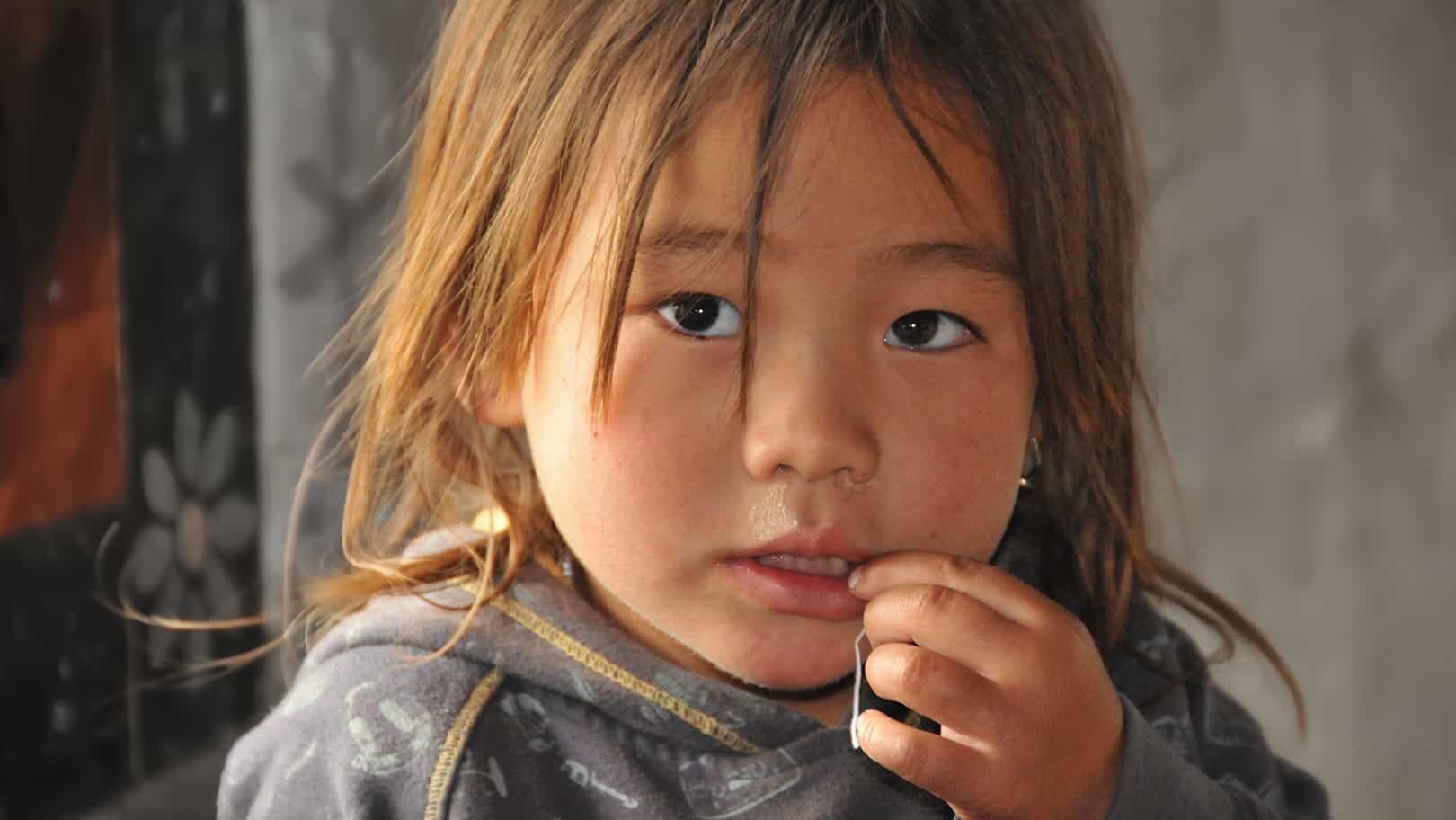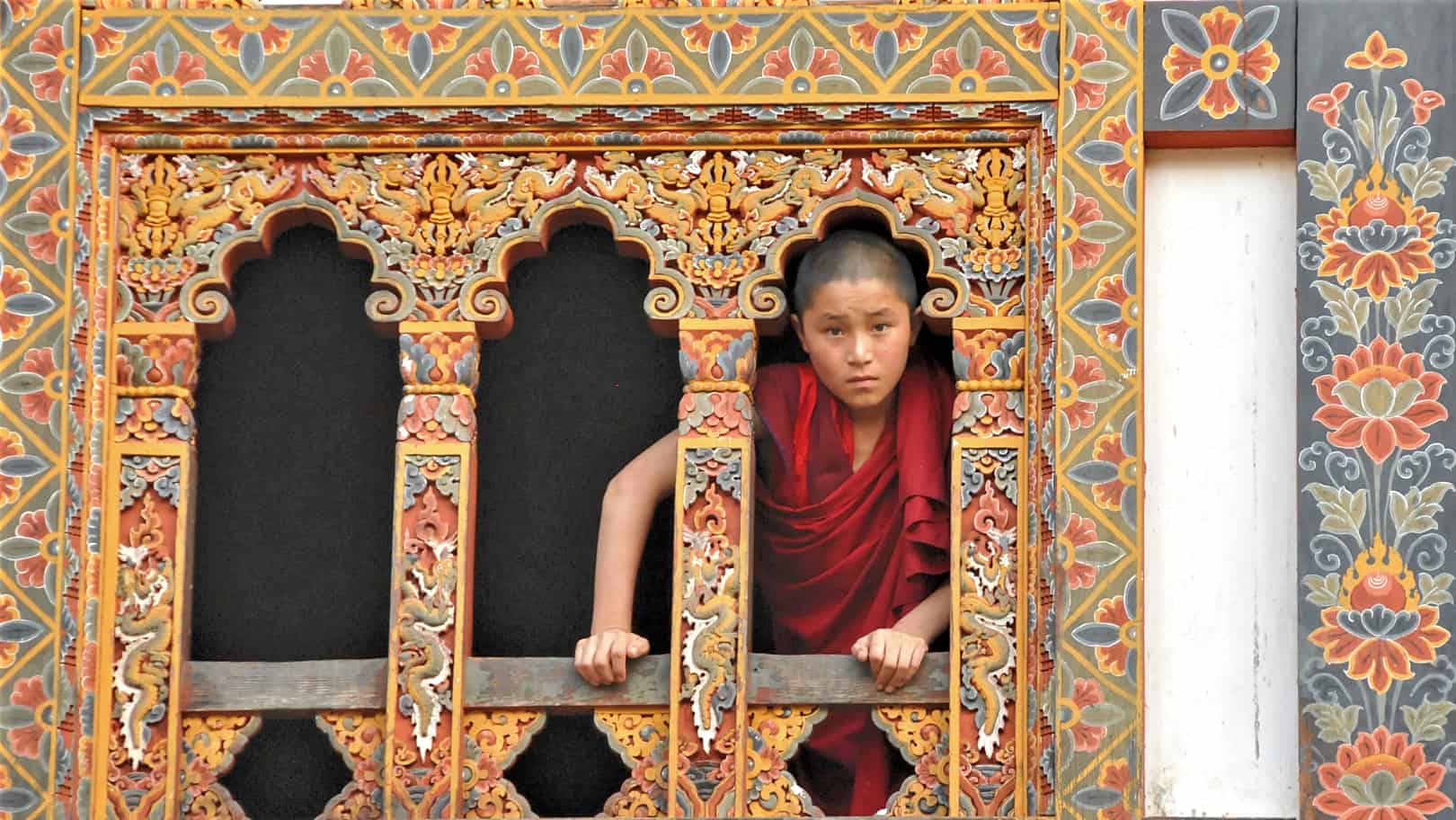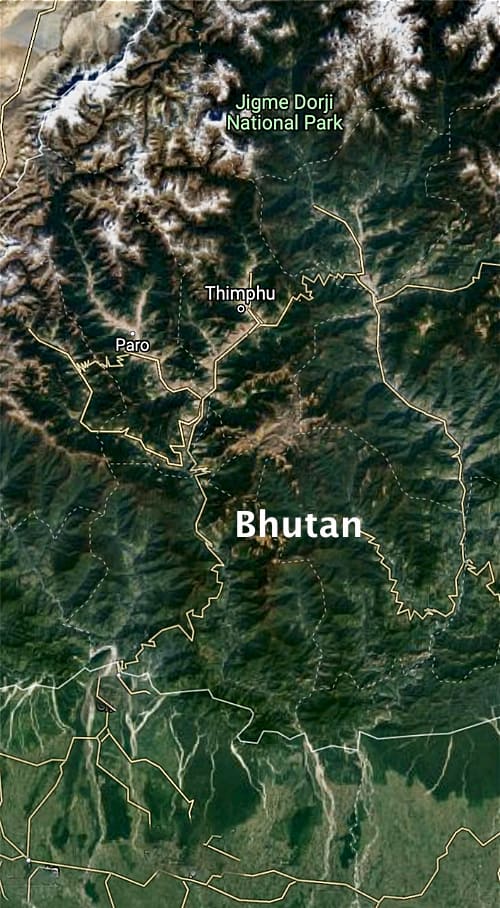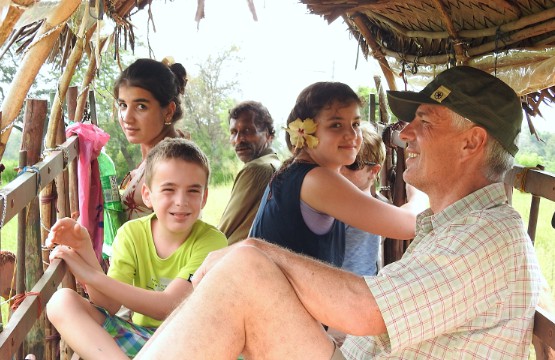Bhutan for Family
Bhutan is a country nestled in the eastern Himalayas. It is a land of superlatives, the last surviving example of a Tibetan Buddhist Kingdom that proudly guard and treasures its cultural and natural heritage. Blessed with a tiny population and steep inaccessible valleys and rolling hills and towering crags, with... More
Bhutan is a country nestled in the eastern Himalayas. It is a land of superlatives, the last surviving example of a Tibetan Buddhist Kingdom that proudly guard and treasures its cultural and natural heritage. Blessed with a tiny population and steep inaccessible valleys and rolling hills and towering crags, with only small patches of cultivation, it holds fabulous pristine forest that are almost entirely untouched and full of wild lives.
Bhutan is not an ordinary place. It has one foot in the past and one in the future. The country has only opened its doors to foreigners quite recently, and although it does so with outstanding hospitality, it is not without some reserve, wishing to avoid the negative side-effects of uncontrolled tourism apparent in other developing nations.
Number of visitors is restricted as the government imposes a fixed and very high daily tariff. The visitors will be enlivened by a series of splendid and impressive dhonz (fortress & monasteries) that usually occupy eagle nest locations of strategic importance. The Bhutanese people still dress in traditional garb and their customs and lifestyles are preserved with enthusiasm and pride.
We have planned this trip carefully in such a way that all of these aspects of Bhutan and its people are combined to make a most rewarding and thrilling culture & nature tour destination for the entire family to explore and experience together!
LessHighlights
- Participation in Archery session
- Cooking class & dinner or lunch at Village home
- Traditional Hot Stone bath
- See closely a typical day in the life of Bhutanese school children
- Visit a school of arts and crafts in Thimphu and observe young boys and girls mastering the skills of thirteen arts and crafts
- Watch how the medicines are purely made from mountainous herbal plants at Indigenous Herbal medicinal centre in Thimphu
- Witness mastery of waverers in a traditional weave center
- Cultural program by traditional dancers
Welcome to Bhutan! Upon arrival in Paro, clear customs and immigration. Meet your Guide and driver outside the terminal building and transfer to Thimphu. Before you drive to Thimpu visit the oldest temple Kyichu Lhakhang in Paro and attend the special welcome ceremony especially organized for you. Get blessing from the local lama priest and leave for Thimpu. In Thipmu time permits stroll around the capital city after check-in to the hotel in Thimphu. Overnight in Thimphu.
Kyichu Lhakhang in Paro
Tibetan King Songtsen Gompo in the 7th century miraculously built 108 temples, along with Jorkhang in Lhasa. Kyichu is considered to be one of them and is one of the oldest temples in Bhutan.
Drive from Paro to Thimphu
The distance of about 65 km from Paro town takes about little more than 1 hour. Drive south following Pachu river to the river confluence at Chuzom, which is also the hub of road network going to Paro, Ha, Thimphu and Phuntsholing. From Chuzom, the drive takes about 1 hour, staying close to the Wangchu River in the valley floor, as you pass through villages and suburbs to the capital, Thimphu. En-route, you can stop to view Tachogang temple and the nunnery at Sitsina.
Thimphu (2,300 m)
Was a wooded farming valley until 1961, when it became Bhutan’s official national capital. The massive Tashicho Dzong, about 700 years old, was carefully revamped in the 1960s by the late King Jigme Dorji Wangchuk to house the royal and main government offices. Even today, it still only has a few streets and no traffic lights with estimated population of 105,000 people.
Accommodation: Hotel Riverview
Meals: Lunch, Dinner
Full day sightseeing in Thimphu. Visit Memorial Chorten, Takin Sanctuary, Buddha Point, handmade paper factory and weekend market. Towards end of the day visit Tashicho
Dzong. Overnight in Thimphu.
Memorial Chorten
This landmark of Thimphu was built in 1974 in the memory of third King, Jigme Dorji Wangchuk, who is popularly regarded as Father of Modern Bhutan. It is a four-storey tall white building, containing statues and iconography of deities from complex tantric teachings and serves as an important place of worship for Thimphu residents, as well as from other parts of the country. Takin Sanctuary: Takin (Budorcas taxicolor) has been chosen as the national animal of Bhutan is based both on its uniqueness and its association with country’s history and mythology. It is said that Devine Madman, a popular saint is said to have created it with his magical power at a large congregation of devotees. It resembles like a cow from back and goat in the front and continues to befuddle taxonomists, who cannot quite relate to other animal.
Buddha Point
This is a new monument and main highlight of Thimphu valley. It has 165 meter high Buddha Statue
Paper Factory
Traditional papers were made from the daphne plant, using simple methods. Weekend Market:The colorful weekend market of Thimphu is held from Friday-Sunday. Residents of Thimphu and country sides come to shop for food and clothes. There are some handicrafts and gifts shop as well, and provide a great photography scene.
Tashichhodzong
This fortress serves as the office of the King, ministers and various government organizations. It also is the headquarters for central monastic body of Bhutan. Bhutan’s spiritual leader Je-Khenpo and the monks of both Thimphu and Punakha reside here during summer. It is also the venue for Thimphu Festival in the fall season.
Accommodation: Hotel Riverview
Meals: Breakfast, Lunch, Dinner
We leave Thimphu for Punakha which takes about 3 hours. In the afternoon, easy hike to the Fertility Temple (Chimi Lhakhang)and explore the local village. Overnight in Punakha.
Drive from Thimphu to Punakha/Wangdue
The drive from Thimphu (75 km) takes about 3 hours. The road climbs from Thimphu to Dochula pass and descends through ever changing forests into the semi-tropical valley of Punakha and Wangdi at around 1200 m. En-route stop at Dochula pass (3050m) where you can view the eastern Himalayas, including Bhutan’s highest mountain, Gangkar Punsum (7,550 m).
Fertility Temple (Chimi Lhakhang)
A monastery and fertility temple dedicated to Lama Drukpa Kuenley, a Tibetan Buddhist saint known popularly as “the divine madman” and considered a folk hero in Bhutan for his unconventional ways. Drukpa Kuenley originally built a chorten on the site in the 14th century, on which a temple was later built in 15th century. The temple, flanked by nearly 100 tall prayer flags, sits atop a picturesque hill. It has long been a pilgrimage site for childless couples. This easy walk takes about 1⁄2 hour each way.
Accommodation: Hotel Zangtho Pelri
Meals: Breakfast, Lunch, Dinner
Morning visit historical Punakha Dzong – the sacred site of Royal Wedding.
In the afternoon free for individual activities. Overnight stay in Punakha.
Punakha Dzong: Or Pungthang Dechen Phodrang “Palace of Great Happiness” popularly known as Punakha Dzong, located on the confluence of two rivers; Pho and Mochu was built in 1637 by Shubdrung Nawang Namgyal. It serves as winter residence for the Central Monastic body, which migrate from Thimphu to Punakha in the winter. It is also the venue for Punakha Festival held in February or March.
Accommodation: Hotel Zangtho Pelri
Meals: Breakfast, Lunch, Dinner
After breakfast, drive to Gangtey (Phobjikha). En route stop briefly at old Wangdiphodrang town. On arrival in Gangtey, visit Gangtey Gompa (monastery) and take a walk in the valley if time permits. Overnight in Phobjikha.
Drive from Punakha to Gangtey (Phobjikha)
Drive to Gangtey (Phobjikha) takes about 2 1⁄2 hours covering distance of 60 km. The road climbs from Wandue, drive uphill almost crosses over Pele La pass 3400m. Before, reaching the pass, the road diverges and we take the road least traveled by. This eventually leads into the ‘hidden valley’ containing the stunningly beautiful monastery of Gangtey Gompa. Phobjikha Valley: Phobjikha (3000m) is a wide-glacial and beautiful valley, designated as conservation
zone within the Black Mountains National Park, a natural habitat for wildlife, including nesting blacknecked cranes from Central Asia (mid autumn till early spring). Because of the conservation measures, there is no electricity in the valley. The lodges use solar powered cells or generator to light which is turned of after dinner. Hot water is provided in the bucket and rooms are heated with wood stoves.
Gantey Gompa
Gantey Gompa monastery sits atop a hillock that overlooks the Phobjikha valley. It is headed by the ninth Gangtey Trulku and is the largest Nyingma monastery in western Bhutan. It was founded in 1613 by Gyalse Pema Thinlay, a grandson and reincarnation of influential treasure finder Pema Lingpa. Incarnate line of Pema Thinlay, representing the body aspects of Pema Lingpa, contrasted with mind and speech emanations. The monastery has been recently built and surrounding the
monastery are village homes and hermitages.
Black-necked Crane
‘Thrung Trung Karmo’ as this bird is passionately called in Bhutan is subject of many Bhutanese songs and folklore. They are seen among the painting on the walls of temples and Thankga. These endangered species of cranes migrate from Tibet in late autumn and typically stay till the mid march. About 3-400 cranes reside in the wetland in the center of the valley. The Observation & Education Centre (open 7-7pm – Mon-Fri) has informative display about the cranes and conservationeffort in the valley.
Accommodation: Hotel Dewachen
Meals: Breakfast, Lunch, Dinner
Drive to Jakar (Bumthang). Stop at Chendebji Chorten (stupa) enroute. Enjoy lunch at Trongsa and drive to Jakar. Overnight in Jakar.
Drive from Gangtey to Jakar
The drive to Jakar (Bumthang) takes about 5-6 hours covering distance of approx. 160 km. The road climbs again to Pele La pass (3,400 m) where we make stop for views of the snow clad peaks, including that of Bhutan’s sacred peak Mt. Chomolhari. After crossing Pelela pass, descend and pass through the villages of Rukubji, Chendebji, Sephu, Langtel and several other villages and arrive in Trongsa for lunch.
From Trongsa, the drive to Jakar takes about 2 1⁄2 hrs. Climb from Trongsa to Yotong La (3,551 m) and descend into Chumey valley (2,700 m), the first of four Bumthang valleys. Then it is another 45 minutes, past the villages of Zugney and Prakar, and across Kiki la pass (2,860 m) to arrive at Jakar, the administrative center of Bumthang district.
Chendebji Chorten (Stupa)
This chorten stands majestically along the high way connecting west to east. The ground by the side serves as famous site for picnic lunch. This monument was believed to have been built to subdue demons dwelling around the area. It has architectural resemblance to famous Boudha Nath of Nepal.
Bumthang Valley
It is justifiably regarded as the cultural heartland of the kingdom with its many temples, holy sites, languages and traditions. It is here that most kings, rulers or priest were buried or cremated. There are four valleys and Jakar at 2,800m in Chokhor valley is the administrative center and the main town of Bumthang district.
Accommodation: The Mountain Resort
Meals: Breakfast, Lunch, Dinner
After breakfast explore the Valley by visiting the famous Jampay Lhakhang (temple), Kurjey temple complex, if time permits and if you walk to Tamshing. After visit to Tamshing, walk down through the local Bhutanese villages and farms to Swiss Farm to see beer making and cheese making in progress.
Later you will also visit Jakar Dzong. Evening free to stroll around. Overnight in Jakar.
Places of interest in the Valley
Jambay Lhakhang is another one of the geomantic temples (like Kichu in Paro) founded in 7th century by a Tibetan King Songtsen Gompo, this time on the ‘left knee of the ogrees’. Guru Rinpoche is said to have taught the local king Sindhu Raja from the temple roof in the 8th century.
Kurjey Lhakhang: Kurjey is named after the sacred power place where Guru Rinpoche (8th century) left the imprint of his body on the solid rocks, which can be seen from inside the shrine. There are three large temples within the complex surrounded by a perimeter comprising of 108 stupas. Upon entering, the first temple to the right is Guru Lhakhang (which houses the cave) dating from 1652. The middle temple Sampalundrup was built by the first King Ugyen Wangchuk in 1900, during his tenure as Trongsa Penlop. The third temple is recently constructed under patronage of Her Majesty queen mother Ashi Kesang Wangchuk.
Tamshing Temple: Located opposite Kurjey Lhakhang this temple was founded by Bhutan’s own religious treasure discoverer, Terton Pema Lingpa in 1501. Believed to be the reincarnation of Guru Rinpochey, he discovered many religious treasures around the country. The original murals on the walls still survive, which are considered to be the oldest extant painting in Bhutan.
Jakar Dzong: “Jakar Dzong” literally meaning castle of the white bird is in a picturesque location overlooking the Chokhor valley. The current structure was built in 1667 and later refurbished in 1683, is said to be one of the largest dzong in Bhutan, with impressive fortress walls, elegant structure but rather simple interior.
Swiss Farm Area: There is a small factory on the other side of the river which produces Swiss Cheese, Bumthang honey and apple wine and local beer called ‘Red Panda’. It is an interesting place to visit and taste some local made products, started by a Swiss Bhutanese.
Accommodation: The Mountain Resort
Meals: Breakfast, Lunch, Dinner
Drive from Jakar to Trongsa is 69 km takes about 2 1⁄2 hours. You will drive across Kikila pass and another highest pass Yotongla at 3,551 m en route and finally descend down to Trongsa.
Afternoon visit Trongsa Dzong and if interest further visit Ta Dzong or get back to your hotel and enjoy the panorama view of the Valley. Overnight in Trongsa.
Trongsa
Trongsa (2,300 m) lies at the geographical center of Bhutan. The town of Trongsa has been developing since 1980’s, with many of the shops being owned by Bhutanese of Tibetan decent. This small town located is on the face of the ridge and at the cross-road junction of lateral east-west highway, and the road leading south to Shemgang.
Trongsa Dzong or Choekhor Rabdentse is the largest and most impressively situated dzong in Bhutan, perched high on a cliff above the deep Mangdechu river gorge. It was built in 1648 on the site of temple which was built in 1543. The huge many-level fortress with its intricate wood carvings has a maze of courtyards and covered passages that follow the contour of the ridge. First and second King ruled the country from this fort and all successive Kings have held the post of Trongsa Penlop, (honorary governor) prior to being crowned as the King.
Ta Dzong: The watchtower above the town area is shaped like tower with wings. It contains a shrine dedicated to Gesar, the legendary epic warrior king, and another named after Jigme Namgyal, the father of the first king. The views from the tower of the dzong and town is spectacular and in ancient times, all approaches could be monitored from here.
Accommodation: The Yangkhil Resort
Meals: Breakfast, Lunch, Dinner
After breakfast, you will drive to Punakha via Chendebji Chorten and across Pelela pass. Overnight in Punakha.
Drive from Trongsa to Punakha:
The distance is 145 km and takes about 5 1⁄2 hours to reach Punakha. Leaving Trongsa, the road winds for 14 kms north west via Tsamkhar to cross Mangde chu river at Bjizam. After driving for nearly one hour, you can still see the Trongsa Dzong, so close enough that you feel as though you can touch. Retrace through the villages of Tangsibji, the chorten at Chendebji stupa, and then though villages of Sephu Nikachu, Rukubji and climbing up the nomadic settlements, and Yak country to Pele la pass (3,420m). From the pass, the road downhill through changing vegetation takes you to Wangdiphodrang and then to Punakha.
Accommodation: Hotel Zangtho Pelri
Meals: Breakfast, Lunch, Dinner
Today, we will drive back to Paro via Thimphu. After lunch at Thimphu, continue drive to Paro. In the afternoon you have time to explore down town Paro on your own, do shpping etc. Overnight in Paro.
Drive from Punakha to Paro via Thimphu: The drive takes about 5 hours covering a distance of 142 km. From Punakha, drive west and climb up to Dochula pass (3,050m), where you have another opportunity to view the peaks of the eastern Himalayas. Descend to Thimphu from Dochula takes about 40 minutes. The western branch of lateral highway from Thimphu, runs close to the Wangchu river in the valley foor, through the suburbs and villages of Thimphu to arrive at the river confluence of Chuzom, which is also the hub of road network going to Paro, Ha, Thimphu and Phuntsholing. From Chuzom, it is north-west for about 1⁄2 hour, following Pa Chu river upstream, passing Tachogang temple on the other side of the river, then through relatively straight road, into the villages and farm houses of Paro valley.
Paro Town: Paro is one of the most beautiful valleys in the country with Bhutan’s only airport located here, among the terraced fields, and elegant farm houses. Willow trees line many of the roads, contrasting with bright colors of the fields and the most popular and important sites also found within Paro district. Paro town (2,280m) is still a small with one main street and less then one hundred small family-run shops. The weekend market in Paro is held on Saturdays.
Accommodation: Tashi Namgay Resort
Meals: Breakfast, Lunch, Dinner
Today you will be taken for a hike to Taktsang Monastery (Tiger’s Nest Monastery). Overnight in Paro.
Hike to Taktsang: Drive to north of Paro town for about 1⁄2 hr and embark on a trek to the famed Taktsang (Tiger’s lair) monastery. Taktsang monastery is located on the face of a 1,000m seemingly impossible sheer, vertical cliff, above Paro valley. The trail begins near the Satsam (2650m) and climbs steeply uphill to the Cafeteria (2,940m), an area of exposed ridge with panoramic view of Takstang. This takes little more then an hour. (Ponies are provided on request to ride up till this Cafeteria, but rest of way, including return downhill must be on foot.) You can get a good view from the Cafeteria or hike further uphill for another hour or so to the temple itself. There are several other temples and sites within the vicinity. Lunch is served at the tea house. The return trek to the road head is quite steep downhill, where you will be met by the transport and drive to the hotel.
Accommodation: Tashi Namgay Resort
Meals: Breakfast, Lunch, Dinner
After breakfast drive to the airport with wonderful memories of Bhutan to catch the outgoing flight to Kolkota.
On the way to your hotel visit Kolkata famous Flower market and the “Slum” at the bank of Hooghly river. Rest of the day free for individual activities or go for a Sunset Cruise followed with nice farewell dinner at the hotel.
Accommodation: The Oberoi Grand
Meals: Breakfast, Dinner
Transfer to airport for your homeward-bound flight.
Note: Depending upon your flight schedule you have an opportunity to Explore Kolkata city before your departure.
The interesting sights are (Optional):
Mother Teresa’s Mother House: In 1950 Mother Teresa founded the Missionaries of Charity (MOC) in the city of Kolkata (Calcutta) to lend aid to the poor, disabled and infirm. What started out as a small community of 12 Sisters has grown to include more than 4,500 volunteer Sisters working worldwide. It is a holy place. Mother’s tomb is on the ground floor and the chapel on the first. Opposite this is the simple room in which Mother lived. You can actually piece together her austere and simple life.
Victoria Memorial Hall: Built entirely of white marble, one of India’s most beautiful monuments which represent a unique combination of classical European architecture and Mughal motifs. The domed and white marble museum sprawls over 64 acres and is set in a landscaped garden at the southern side of the Kolkata’s maidan (ground) near Jawaharlal Nehru Road. It has a vast collection of pictures, statues, manuscripts, letters etc, relating to the Nawabi and British times in Bengal.
Flower Market: In the early morning this market gets filled with colorful flowers from the northern part of Calcutta. You can see flowers everywhere in this market on the ground, on people’s head, in carts and trucks and on display. By 7PM the market start winding down and by 8 pm all the sale is over.
Town Hall: Town Hall displays Palladian Neo-classical Doric style architecture and has been used as the Town Court House as well as the office of Public Services Commission. Constructed in 1813 using wood and bricks. The 25 feet high ground floor has an intricate network of numerous small rooms and a central marble hall. Numerous community meetings and social gatherings have been organized in front of the town hall of Kolkata.
Meal: Breakfast
Included
- Airport (pick up/drop off) transfers by private A/C vehicle
- Bhutan visa
- Twin-Sharing accommodation in all Hotel/Resort/Lodge as mentioned
- All meals (breakfast, lunch, dinner), afternoon tea and bottled water throughout the tour
- All sightseeing and long distance transportation in private air-condition vehicle (cars/SUVs or mini/micro-bus etc. depending on group size). This includes all state taxes, toll taxes, parking, allowance for driver, outstation overnight charges for the driver
- All sightseeing as per the itinerary
- English speaking licensed tour guide
- All entrance fees to the mentioned monument/museum
- Road permit, royalty and all internal taxes
- All applicable government taxes
Not Included
- International flight tickets
- Travel insurance & vaccinations
- Meals not mentioned in the itinerary
- Personal equipment and clothing
- Tips for tour leader/guide, driver, hotel staff and porters
- Items of personal nature such as alcoholic beverages, soft drinks, laundry, showers and other unforeseen expenses
- Anything not mentioned in the above ‘Included’
Price: US$ 4,550 per person (Twin Sharing Basis | Based on Minimum 3 Travelers)
Single Supplement: US$ 535
Bhutan Visa Fee: US$ 40
Your Feedback
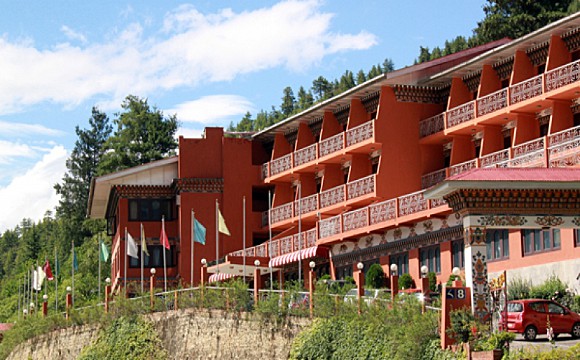
Hotel Riverview, Thimphu
One of the finest properties in Thimphu, elegantly situated on the East bank of Thimphu River. It presents commanding view of both town and the valley. An interesting feature of the place is the fact that all the rooms overlook Thimphu River and have private balconies offering panoramic vistas.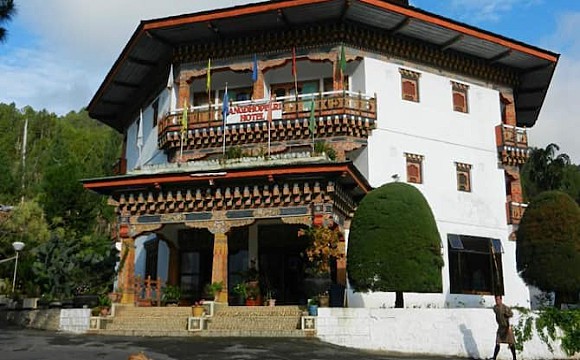
Hotel Zangtho Pelri, Punakha
Named after the heaven of Guru Rimpoche and situated majestically on a hillock, the hotel features spacious, well designed rooms in small cabins as well as in main building. A charming place to stay, the guests enjoy fascinating view of the rice terraces, Punakha river and constantly changing Himalayan valley weather.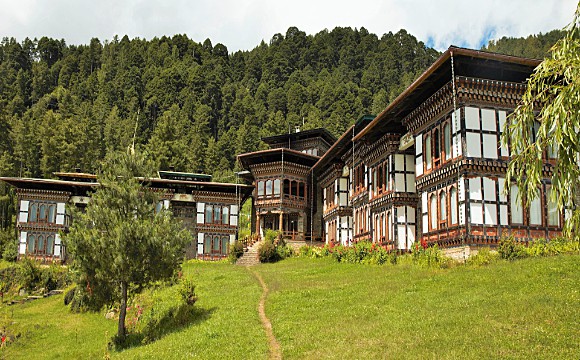
Dewachen Hotel & Spa, Gangtey
Encircled by pine forests in the picturesque valley of Phobjikha, Dewachen hotel features 28 spacious, comfortably furnished rooms, with en suite facilities. All rooms are designed and decorated in traditional Bhutanese style perfectly blended with natural surroundings, for a perfect hideaway relaxation. Rooms are well heated by traditional ‘bukhari’ (iron stove), so you feel cozy and comfortable during cold winter nights.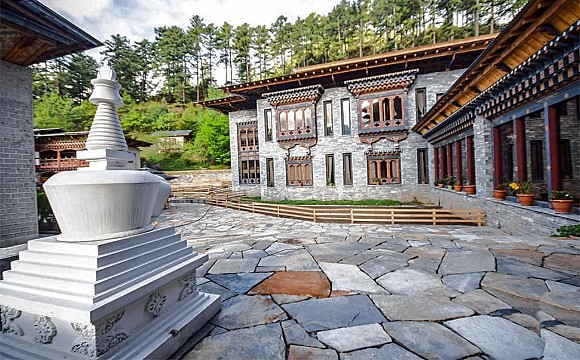
The Mountain Resort, Bumthang
The Mountain Resort in Bumthang has come a long way without losing its roots. Our family-run resort was started by a man of exceptional kindness, who dreamed of a place that would be gracious, spacious, and rooted in the genuine traditions of Bhutanese hospitality - a place brimming with the love of our dearly beloved family elder.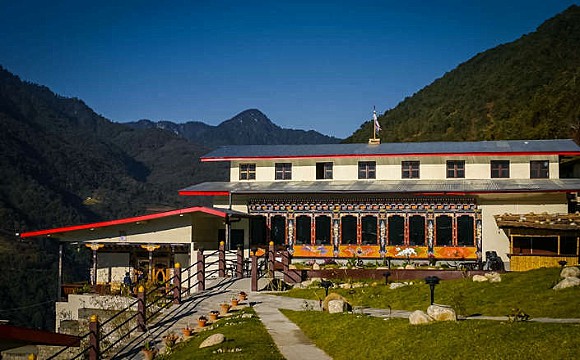
The Yangkhil Resort, Trongsa
The Yangkill Resort is situated not far from the Trongsa offering spectacular views of the deep valleys surrounding it. Resort has 21 spacious rooms of modern design combined with traditional Bhutanese architecture and wooden flooring. All rooms are fully insulated and the bathroom has a bathtub with a shower over. Hot and cold running water is available all day long.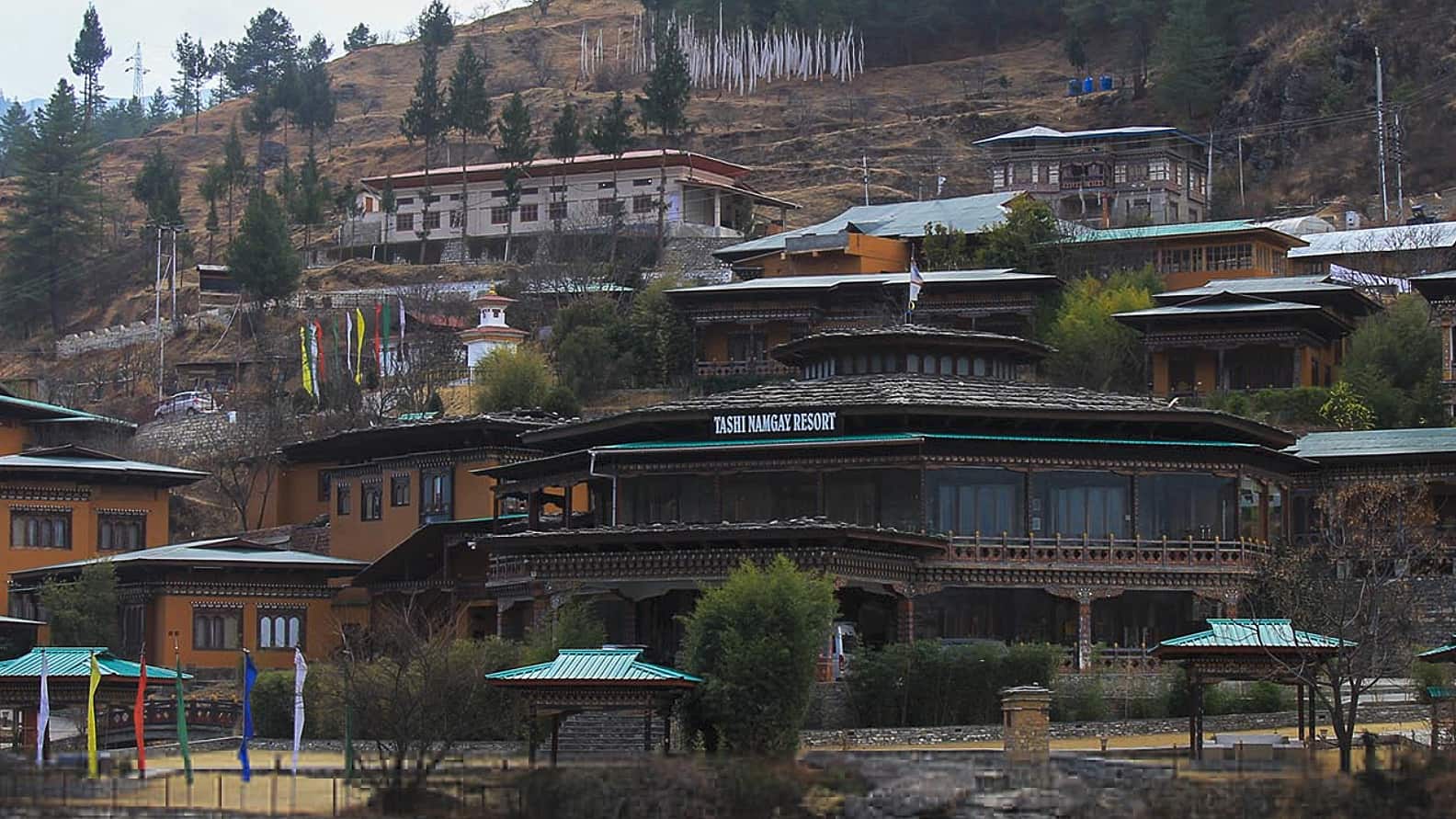
Tashi Namgay Resort, Paro
The resort is set amidst five acres of lush foliage and green lawns. Located conveniently in the heart of Paro Valley but away from the distractions of the main town, Tashi Namgay Resort offers you a calm and peaceful environment within its compound. Traditional Bhutanese and modern architecture have been uniquely blended, yet offering all the amenities of a modern lifestyle.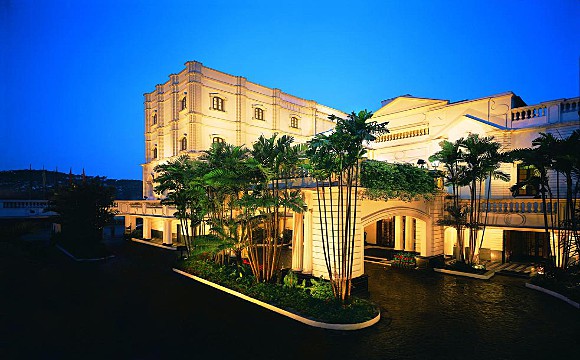
The Oberoi Grand, Kolkata
Fondly referred to as the Grand Dame of Chowringhee, our 5 star hotel: The Oberoi Grand has been an icon on the landscape of Kolkata for more than a century; with a reputation for taking care of its guests that befits the best hotel in Kolkata.The sense of calm that pervades the outdoor space is carried into the classically appointed rooms and suites that encircle the courtyard.Giving back to the communities is our responsibility!
With every trip, you also support the SWAN and thus projects for Sustainable Community development and Biodiversity protection.
Our primary NGO partner is Social Welfare Association of Nepal (SWAN), with whom we have carried out multiple CSR (Corporate Social Responsibility) projects. Besides carrying out regular CSR activities in the areas of education and women empowerment, we have supported relief and rehabilitation initiatives in the aftermath of several natural disasters like earthquake, immediate response to COVID-19 pandemic across Nepal.
Giving something back to the world is a special and responsible affair of travel-to-nature Asia right from its inception. When you travel with travel-to-nature Asia and SWAN-Nepal, you become an integral force for change in addressing the most pressing social and wildlife conservation issues. Your tourism funds help transform the future of under-privileged and marginalized communities and transform the future of at-risk natural places you travel. Portion of our profit flows to local communities who live with and steward nature, creating jobs and improving livelihoods.
By joining one of our holidays you are playing a vital role in bringing positive changes in the lives of local community.

